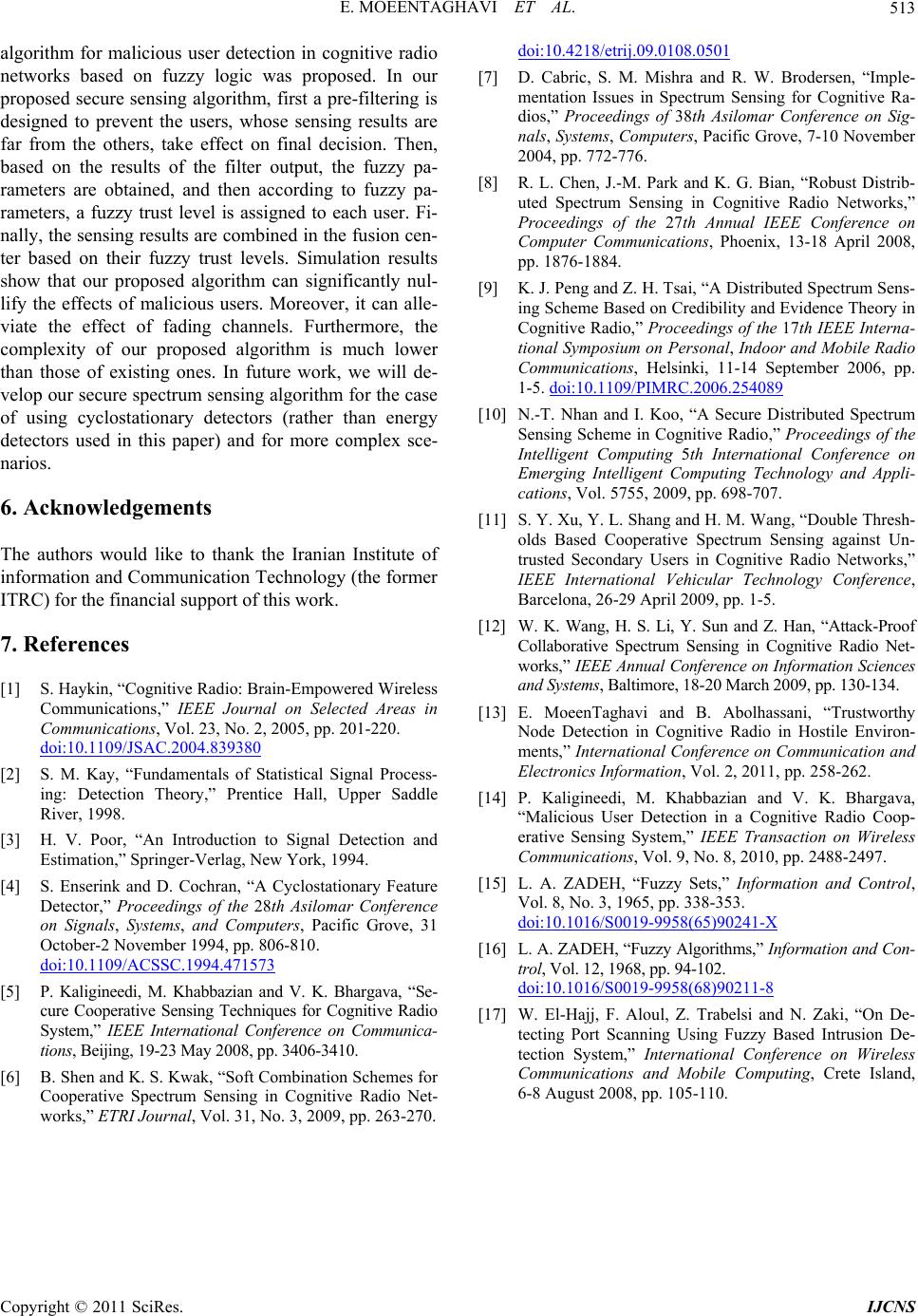
E. MOEENTAGHAVI ET AL.
Copyright © 2011 SciRes. IJCNS
513
algorithm for malicious user detection in cognitive radio
networks based on fuzzy logic was proposed. In our
proposed secure sensing algorithm, first a pre-filtering is
designed to prevent the users, whose sensing results are
far from the others, take effect on final decision. Then,
based on the results of the filter output, the fuzzy pa-
rameters are obtained, and then according to fuzzy pa-
rameters, a fuzzy trust level is assigned to each user. Fi-
nally, the sensing results are combined in the fusion cen-
ter based on their fuzzy trust levels. Simulation results
show that our proposed algorithm can significantly nul-
lify the effects of malicious users. Moreover, it can alle-
viate the effect of fading channels. Furthermore, the
complexity of our proposed algorithm is much lower
than those of existing ones. In future work, we will de-
velop our secure sp ectrum sensing algorithm for the case
of using cyclostationary detectors (rather than energy
detectors used in this paper) and for more complex sce-
narios.
6. Acknowledgements
The authors would like to thank the Iranian Institute of
information and Co mmunication Technology (th e former
ITRC) for the financial support of this work.
7. References
[1] S. Haykin, “Cognitive Radio: Brain-Empowered Wireless
Communications,” IEEE Journal on Selected Areas in
Communications, Vol. 23, No. 2, 2005, pp. 201-220.
doi:10.1109/JSAC.2004.839380
[2] S. M. Kay, “Fundamentals of Statistical Signal Process-
ing: Detection Theory,” Prentice Hall, Upper Saddle
River, 1998.
[3] H. V. Poor, “An Introduction to Signal Detection and
Estimation,” Springer-Verlag, New York, 1994.
[4] S. Enserink and D. Cochran, “A Cyclostationary Feature
Detector,” Proceedings of the 28th Asilomar Conference
on Signals, Systems, and Computers, Pacific Grove, 31
October-2 November 1994, pp. 806-810.
doi:10.1109/ACSSC.1994.471573
[5] P. Kaligineedi, M. Khabbazian and V. K. Bhargava, “Se-
cure Cooperative Sensing Techniques for Cognitive Radio
System,” IEEE International Conference on Communica-
tions, Beijing, 19-23 May 2008, pp. 3406-3410.
[6] B. Shen and K. S. Kwak, “Soft Combination Schemes for
Cooperative Spectrum Sensing in Cognitive Radio Net-
works,” ETRI Journal, Vol. 31, No. 3, 2009, pp. 263-270.
doi:10.4218/etrij.09.0108.0501
[7] D. Cabric, S. M. Mishra and R. W. Brodersen, “Imple-
mentation Issues in Spectrum Sensing for Cognitive Ra-
dios,” Proceedings of 38th Asilomar Conference on Sig-
nals, Systems, Computers, Pacific Grove, 7-10 November
2004, pp. 772-776.
[8] R. L. Chen, J.-M. Park and K. G. Bian, “Robust Distrib-
uted Spectrum Sensing in Cognitive Radio Networks,”
Proceedings of the 27th Annual IEEE Conference on
Computer Communications, Phoenix, 13-18 April 2008,
pp. 1876-1884.
[9] K. J. Peng and Z. H. Tsai, “A Distributed Spectrum Sens-
ing Scheme Based on Credibility and Evidence Theory in
Cognitive Radio,” Proceedings of the 17th IEEE Interna-
tional Symposium on Personal, Indoor and Mobile Radio
Communications, Helsinki, 11-14 September 2006, pp.
1-5. doi:10.1109/PIMRC.2006.254089
[10] N.-T. Nhan and I. Koo, “A Secure Distributed Spectrum
Sensing Scheme in Cognitive Radio,” Proceedings of the
Intelligent Computing 5th International Conference on
Emerging Intelligent Computing Technology and Appli-
cations, Vol. 5755, 2009, pp. 698-707.
[11] S. Y. Xu, Y. L. Shang and H. M. Wang, “Double Thresh-
olds Based Cooperative Spectrum Sensing against Un-
trusted Secondary Users in Cognitive Radio Networks,”
IEEE International Vehicular Technology Conference,
Barcelona, 26-29 April 2009, pp. 1-5.
[12] W. K. Wang, H. S. Li, Y. Sun and Z. Han, “Attack-Proof
Collaborative Spectrum Sensing in Cognitive Radio Net-
works,” IEEE Annual Conference on Information Sciences
and Systems, Baltimore, 18-20 March 2009, pp. 130-134.
[13] E. MoeenTaghavi and B. Abolhassani, “Trustworthy
Node Detection in Cognitive Radio in Hostile Environ-
ments,” International Conference on Communication and
Electronics Information, Vol. 2, 2011, pp. 258-262.
[14] P. Kaligineedi, M. Khabbazian and V. K. Bhargava,
“Malicious User Detection in a Cognitive Radio Coop-
erative Sensing System,” IEEE Transaction on Wireless
Communications, Vol. 9, No. 8, 2010, pp. 2488-2497.
[15] L. A. ZADEH, “Fuzzy Sets,” Information and Control,
Vol. 8, No. 3, 1965, pp. 338-353.
doi:10.1016/S0019-9958(65)90241-X
[16] L. A. ZADEH, “Fuzzy Algorith ms,” Information a nd Con-
trol, Vol. 12, 1968, pp. 94-102.
doi:10.1016/S0019-9958(68)90211-8
[17] W. El-Hajj, F. Aloul, Z. Trabelsi and N. Zaki, “On De-
tecting Port Scanning Using Fuzzy Based Intrusion De-
tection System,” International Conference on Wireless
Communications and Mobile Computing, Crete Island,
6-8 August 2008, pp. 105-110.